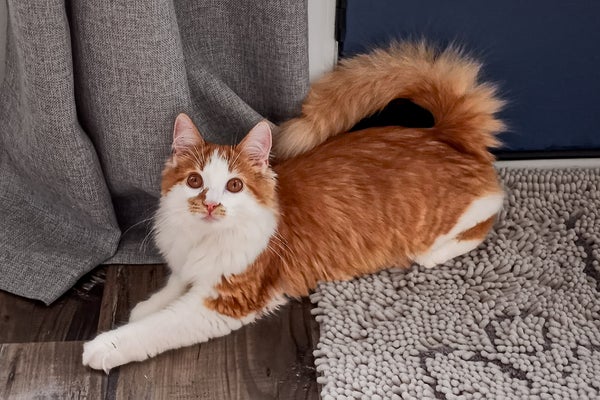Curly-Tailed Cats Communicate with an Accent
November 15, 20243 min readMiaou! Curly Tails Give Cats an AccentA genetic mutation makes some cats tail curl over their back, giving them something akin to an accent when they communicate with other kittiesBy Christa Lest-LasserreBaby the cat has a genetic mutation that makes his tail curl over his back in a spitz-like position. Erica HudsonOwning a cat with a trendy feature, such as a salty licorice coat color or the flat face of a Persian feline, might be the cats meow. But some trendsincluding a curled-back tail thats gaining popularity among ownersmay unintentionally complicate a kittys social life. These cute but unusual tails could give a feline a sort of nonverbal accent to other cats (or humans), researchers say.Cats have a large repertoire of body language signals. They arch their back, raise their fur and flatten their ears to communicate fear or stress. They squint, knead their paws and rub their head against someone when showing affection and trust. And one of their most common contentment cues is a simple straight-up tailheld vertical and sometimes a little curved at the tipwhich translates to other kitties as Hey there, friend!Morgane Van Belle, a feline ethologist at Ghent University in Belgium, was researching cat-to-cat interactions in peoples homes when she came across some surprising tails that bent completely over the cats backs. Participants sent her videos of two cats from unrelated households that could wave, swish, twitch and drop their tail but couldnt hold it straight up. The owners said their respective cats tail had always been this way, suggesting a genetic mutationone that is likely also involved in a new breeding effort to promote curly tails. The proposed name for the breed with this trait is the American ringtail (not to be confused with the small mammal from the raccoon family).On supporting science journalismIf you're enjoying this article, consider supporting our award-winning journalism by subscribing. By purchasing a subscription you are helping to ensure the future of impactful stories about the discoveries and ideas shaping our world today.Curious about how curly tails affect cats ability to communicate, van Belle and her colleagues watched 85 minutes of video footage of the two curly-tailed felines interacting with other cats that lived in their respective homes. Normal-tailed cats happily groomed, played, rubbed heads and slept with the odd-tailed kitties they lived withmeaning the animals had likely found some other way to communicate friendly messages, the researchers report in a new paper published in the Veterinary Journal.The curled tail gives a cat something a bit like an accent that may take some time and effort for others to understand, says Van Belle, who was lead author of the paper. Maybe theyre using other cues, like ear position or odors instead, she adds. Knowing each other very well probably also helps in the communication. It really shows how flexible cats are when communicating with each other.Erica HudsonSandra Nicholson, an animal behavior scientist at University College Dublin, who was not involved in the new paper, concurs. Theyre still signaling through other parts of their body, with their face, their ears and their body position as a whole, she says. So its not just about the tailalthough obviously that [curled tail] is going to reduce some of their signaling ability.Unfamiliar felinesand even humansrisk misinterpreting curly-tailed cues. These cats could be sending confusing messages, Nicholson says. Indeed, tails that curl over the back dont even seem to exist in the kitty language repertoire because most cats cant make this move at all.Whether communication challenges exist among the approximately 70 breeds of curly-tailed spitz dogs, such as Pomeranians and Shiba Inus, remains to be explored, says one of the new studys co-authors, Daniel Mills, a veterinary behaviorist at the University of Lincoln in England. Breeds who only experience their own breed may be more limited in their ability to communicate across all breeds, he says, noting the importance of socializing a dog with a diverse range of breeds.On a broader scale, the cat study highlights the need to consider how fashionable breeding characteristics may affect not only animals physical health but their social health as well, says evolutionary ecologist Brittany Florkiewicz of Lyon College, who was not involved in the new paper. Snub-nosed animals such as pug dogs and Persian cats cant create all the normal facial expressions for their speciesin addition to struggling to breathe correctly.On a more positive note, Nicholson points out that the paper highlights cats ability to adapt to one anothers individual variations. These animals need to be supported and included and not disadvantaged as a result of their differences, she explains. Here we see theyre living their lives normally, and I find that quite inspiring.


